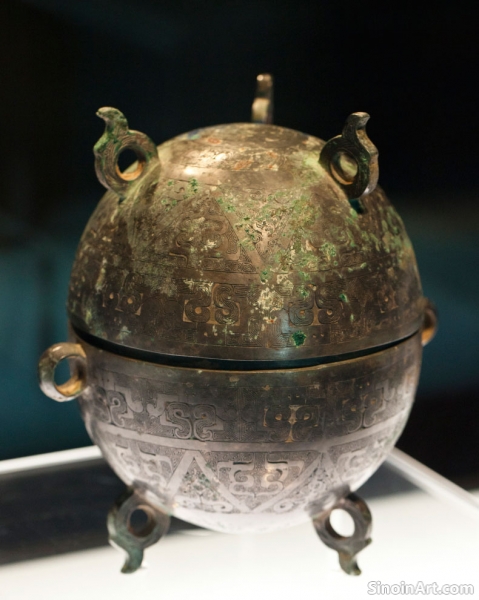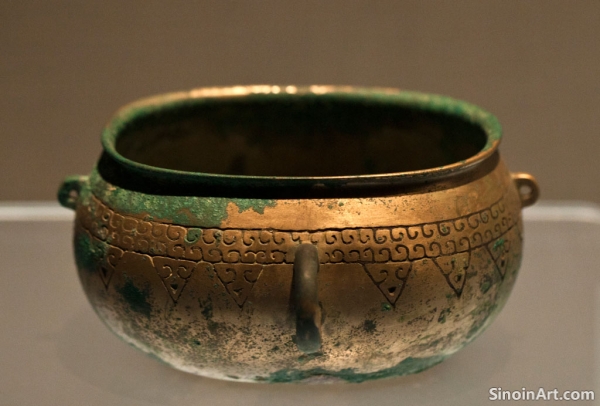The Ritual Vessels of the Shang Dynasty: Power and Symbolism in Bronze
|
The ritual vessels of the Shang Dynasty (c. 1600-1046 BCE) represent some of the most iconic and powerful examples of ancient Chinese bronze ware. These vessels, meticulously crafted with intricate designs and robust forms, served as essential instruments in ancestral rites and other important ceremonies. They were not merely containers but rather potent symbols of social status, religious authority, and the communication between the living and the spirit world. Their importance in the Shang Dynasty is difficult to overstate.  The Shang Dynasty was characterized by a hierarchical social structure and a strong emphasis on ancestor worship. Bronze vessels were used to hold food and wine offerings for deceased ancestors, acting as a means of connecting with the past and ensuring the continued prosperity of the lineage. The type and number of bronze vessels used in a ritual directly reflected the social status of the individual or family involved. This clearly shows the connection between power, prestige and the use of bronze.  Among the most common Shang bronze vessels were the ding (鼎), a large cauldron with three or four legs, and the gui (簋), a bowl-shaped vessel for grains. The designs on these vessels, which often included the fearsome taotie motif, were not merely decorative but also possessed deep symbolic meanings. The taotie, with its composite animal features, was believed to protect against evil spirits and ensure good fortune. The patterns and forms of these vessels were complex and had a deep symbolic importance.  The craftsmanship involved in the creation of these Shang bronze vessels was remarkable. Bronze workers employed the lost-wax casting method, a complex and time-consuming technique that allowed them to produce intricate designs and precise forms. The high level of craftsmanship required a large amount of time, skill, and expertise. This level of skill has not been often surpassed. The ritual vessels of the Shang Dynasty offer invaluable insights into the religious beliefs and social practices of the time. Their enduring legacy continues to inspire awe and fascination, showcasing the artistic brilliance and technical mastery of ancient Chinese bronze workers. They remain today, not only as artifacts, but also as examples of one of the greatest eras of bronze creation in human history. |
Tag : Shang Dynasty bronzes, ritual vessels, ding, gui, taotie
Related information
- The Preservation of Bronze Artifacts: Understanding the Chemistry of Corrosion and Deterioration
- The Techniques of Inlaying Bronze: Incorporating Precious Materials into Metalwork
- The Art of Bronze Casting: Techniques and Innovations in Ancient China
- The Depiction of Daily Life on Bronze Artifacts: A Window into Ancient Society
- The Use of Bronze in Ancient Chinese Textile Production: Tools and Decorative Elements
This article explores the chemistry of bronze corrosion and deterioration, highlighting the scientific principles behind conservation efforts, and the methods and techniques used to stabilize and preserve these artifacts for future generations.
This article explores the techniques of inlaying bronze in ancient China, highlighting the use of precious materials like gold, silver, and jade, and demonstrating how these techniques added sophistication, symbolism, and artistic value to bronze objects.
This article explores the art of bronze casting in ancient China, highlighting the development of techniques like piece-mold casting and the lost-wax method, and emphasizing the control of alloys, temperature, and the innovations of ancient metalworkers.
This article explores the depiction of daily life on Chinese bronze artifacts, highlighting scenes of hunting, farming, cooking, and social gatherings, and revealing insights into the social structures, economic activities, and everyday routines of ancient Chinese society.
This article explores the use of bronze in ancient Chinese textile production, highlighting its role in creating tools like hooks and needles, decorative elements like buckles, and revealing the interplay of metalworking and textile craftsmanship.